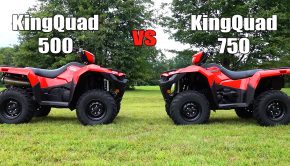Published on November 15th, 2025 | by Joe
2025 Suzuki KingQuad 750 Test Review: WITH VIDEO
Introduction
The largest big-bore, single-cylinder 4×4 ATV on the market, the Suzuki KingQuad 750 4×4 has earned a strong reputation for performance and reliability over the past twenty years. Released in 2005 as the KingQuad 700, it later grew into the 750 and gained power steering in 2009.
We last tested the KingQuad 750 back in 2019, when Suzuki modernized its styling and made a series of updates to improve engine performance, handling, suspension, braking, and ergonomics. The engine’s oil system and frame were updated for improved durability, and towing capacity was increased by 330 pounds thanks to the addition of a 2-inch hitch receiver and frame reinforcements. (Check out our 2019 Suzuki KingQuad 750 Test Review for complete details.)
After testing in 2019, we found that overall engine and clutch responsiveness had improved. Handling felt more planted and predictable, and the shocks wallowed and bottomed less. Overall, it remained the same popular machine—just better in all the right places.
In 2021, high-impact plastic covers were added to the front and rear steel racks on all power-steering-equipped models for a more modern appearance and improved cargo protection. In 2024, Suzuki added handguards and a hitch kit to all Power Steering and higher trim models.
For 2025, we felt it was time to revisit this lightly updated, fun, capable, and often under-hyped ATV.
Trim Packages
For 2025, the base model KingQuad 750 retails for $9,829. The KingQuad 750 with Power Steering adds electronic power steering, rack covers, a hitch kit, and handguards for $10,929.
Available in both camo and non-camo versions, the Power Steering Special Edition model we’re testing adds cast-aluminum wheels and color-matched suspension springs for $11,529.
The Power Steering Special Edition Plus models feature a special hydro-dipped custom color for the same $11,529 MSRP.
We’re also told that a few SE+ models with Suzuki’s Rugged Package are still available at select dealerships. These include a front and rear bumper and an LED front light bar, retailing for $12,099.
Riders and Location
Our KingQuad 750 Test was conducted on a hilly, hill-top private property in West Harrison, Indiana. Riders included former pro ATV MX racer and farmer Aaron Meyer, heavy equipment operator and long-time 4×4 ATV owner Casey Meyer, 450cc Sport ATV XC Racer Isaac Hart, and C-class 4×4 GNCC racer Landon Dean.
Engine Performance
The KingQuad 750 is powered by a 722cc, four-valve, double overhead cam, four-stroke engine featuring Suzuki fuel injection. Its 9.9:1 compression ratio allows it to run comfortably on 87-octane fuel.
Near the top of its class, the engine produces 49.6 horsepower and carries a claimed curb weight of 721 pounds. The cylinder is canted forward 48 degrees, helping achieve a lower seat height and center of gravity. Its 4.6-gallon fuel tank is mounted under the seat to further lower the center of gravity.
Power is delivered through an automatic CVT transmission with engine braking, offering High and Low forward ranges, Neutral, and Reverse, all selected by a gated shifter. The drive system includes 2WD and 4WD with a lockable front differential, engaged via a right-side handlebar-mounted push-button and switch combo.
The engine fires up quickly and consistently, emitting a deep, throaty exhaust note. Suzuki put the power right where it belongs—strong low-end torque and a broad midrange make it run like the “stroker” of the class.
Low-end power is arguably class-leading, helping the KingQuad move large loads easily and torque its way up long climbs without strain. That bottom-end grunt transitions into a strong midrange, allowing the 750 to rip down the trail when things open up. It doesn’t rev as quickly as some competitors, but with instant power on-tap, it doesn’t need to.
Initial clutch engagement off idle is among the smoothest in the class, comparable to the centrifugal clutch-equipped Yamaha Grizzly 700. Clutching is well-tuned to keep the engine working in its low-to-midrange sweet spot, never revving out unnecessarily.
CVT response is quick to keep power on tap when getting back on the gas. Engine braking is strong and smooth without feeling intrusive.
We rode occasionally in 2WD but spent most of our time in limited-slip 4WD for maximum steering precision. Front differential lock wasn’t necessary during testing, but switching between drivetrain modes was smooth and effortless. Driveline chatter under braking was minimal.
Overall, the engine works as hard as it plays—ideal for riders who need an ATV that can handle both work and recreation.
Of course, we’d be remiss not to mention that there’s an additional 10–15% power gain and cooler running temperatures available by installing an HMF Performance, Titan Quiet, or Titan Loud exhaust system, when paired with an HMF fuel optimizer, featuring easy, onboard push-button tuning. Learn more at hmfracing.com.
Handling and Suspension
The KingQuad 750 rides on a tubular steel frame, strengthened after 2019 with beefier main tubes and improved shock and motor mounts. Composite skid plates protect the underside of the frame and A-arms.
Suspension consists of dual A-arms front and rear, delivering 6.7 inches of front travel and 7.7 inches rear—modest by today’s standards. The gas-charged shocks feature five-way preload adjustment, and a rear sway bar helps reduce body roll.
Single-mode electronic power steering (EPS) reduces steering effort and feedback, last updated in 2019 with a 40% power increase.
The KingQuad rolls on 25×8-12 front and 25×10-12 rear Carlisle tires, mounted on cast-aluminum wheels for SE models. We applaud Suzuki for avoiding heavy tires that would sap performance—while 25-inch tires are smaller than many competitors, larger tires might compromise handling due to the ATV’s narrower width.
Dimensions include a 45-inch rear width (tire edge to tire edge), 50.6-inch wheelbase, 36.2-inch seat height, and 10.2 inches of ground clearance, placing it squarely mid-class. Its 721-pound curb weight is respectably light for a big-bore 4×4 single.
On the trail, the KingQuad offers a firm yet forgiving ride. Small-bump compliance is decent, though not as plush as some competitors. However, it doesn’t leave you fatigued even after long rides. The trade-off is excellent bottoming resistance on big hits, and the shocks perform well when towing or hauling.
For owners looking to fine-tune the ride, Elka Suspension offers adjustable shocks that allow riders to optimize the ride for comfort and load handling capabilities. Elka shocks are serviceable and rebuildable, unlike stock units, allowing you to maintain their superior performance for the life of your ATV. Visit elkasuspension.com for more details.
Steering precision is good. The EPS system and firmer factory suspension have reduced the older model’s understeer tendencies, making handling predictable and more confidence-inspiring, even on off-camber downhill turns.
Cornering stability is good, with minimal body roll. When ridden alongside wider machines like the Yamaha Grizzly 700 or Can-Am Outlander 700, the Suzuki feels slightly narrower, but stability remains consistent and predictable.
Smooth power delivery, a long wheelbase, and firmer suspension keep both ends planted on climbs and descents.
We’d like to see more EPS assist at low speeds, particularly with the differential locked. Yamaha’s latest EPS tuning nearly eliminates steering resistance in diff-lock mode. At higher speeds, steering feel is ideal, though we wanted a bit more bump feedback filtration.
Overall, a little extra width and suspension travel would enhance comfort, but Suzuki has steadily improved handling over the years, and we enjoy it more now than ever.
Brakes
Braking is handled by dual hydraulic disc brakes up front and a sealed multi-disc rear brake, operated independently. Separate handlebar mounted levers control the front and rear brake independently, while the right-side foot pedal engages the rear.
Pedal height is ideal, though a transmission bulge makes access slightly awkward with riding boots. Braking power is strong front and rear. The front brakes offer good lever feel, while the rear brake lacks the crisp feedback of a standard disc setup—but still delivers solid stopping power.
Overall braking performance is acceptably balanced and effective, with more than adequate control for both work and trail use.
Ergonomics
The KingQuad is a comfortable, easy-to-ride ATV. The handlebar height increased slightly in 2019, improving control on steep descents. While they feel a little tall on flat terrain, riders who prefer being behind the bars rather than over them will appreciate the setup.
We’ve long been fans of Suzuki’s T-shaped seat, offering an excellent balance of firmness and comfort, and plenty of room to move around.
The steel footpegs integrated into the floorboards provide ample grip and room to pivot your foot, even with some mud buildup. Lever and switch quality is excellent, as expected from Suzuki.
Utility and Work Capability
Suzuki’s racks deliver the best of both worlds—durable steel construction covered by removable high-impact plastic panels for a smooth, modern appearance.
Rated to carry 66 pounds front and 132 pounds rear, the racks are complemented by a 2-inch hitch receiver rated for 1,323 pounds of towing. Power-steering and higher trims come equipped with a hitch kit, making the KingQuad ready for work straight from the dealer.
Storage is plentiful: a 4.0-liter rear box, another 4.0-liter left-side box, and a 2.8-liter water-resistant box on the right front fender.
We overloaded the racks with 100 pounds front and 150 pounds rear, maxing out shock preload settings. The narrower stance required more caution on side hills when fully loaded, but the firm shocks did an excellent job controlling body roll and keeping the ATV stable.
With the front shocks fully softened, we towed over a half-ton load up and down a steep gravel driveway without excessive squat or steering issues. The high-torque engine handled the extra weight effortlessly.
The KingQuad 750 is a highly capable workhorse.
Styling and Details
Styling last received a major update in 2019, and it remains distinctively Suzuki. The addition of rack covers and handguards gives it a more modern look with added function.
The backlit LCD display is bright and easy to read. Front and handlebar-mounted halogen headlights are effective, but consumers have made it clear: it’s time for LEDs. Out back, the LED tail/brake light adds a nice touch.
Conclusion
Suzuki has steadily refined the KingQuad 750 into a machine that remains competitive and well-rounded in today’s market. Its smooth, torquey low-end and midrange power make it approachable for a wide range of riders and applications.
The firm suspension controls body roll and complements its narrower chassis, maintaining stability on sidehills or under load.
We’d still welcome a bit more EPS assist, width, and suspension travel, but overall, the KingQuad 750 delivers dependable, well-balanced performance for both work and play.
Perhaps the biggest question is why the SE trim costs $1,130 more than the Yamaha Grizzly 700 and $1,280 more than the Can-Am Outlander 700 XT.
Fortunately, for late 2025, Suzuki is offering $700 off the KingQuad 750, along with an extremely attractive four-year warranty. With that, its performance and peace of mind make the 2025 Suzuki KingQuad 750 an easy choice.
Even if you’re reading this later, the KingQuad 750 remains a strong contender for your next ATV.








